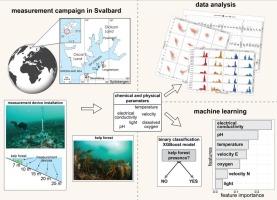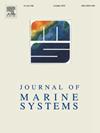Prediction of Arctic kelp forest occurrence using Extreme Gradient Boosting
IF 2.5
3区 地球科学
Q2 GEOSCIENCES, MULTIDISCIPLINARY
引用次数: 0
Abstract
Kelp forests are one of the most productive marine habitats of the world that provide number of valuable ecosystem services for diverse range of species. Understanding the physicochemical factors influencing kelp forest occurrence is vital for comprehending its ecosystems' dynamics. That seems especially important in Arctic environments which are strongly influenced by climate change. Therefore, a high-Arctic fjord (Isfjorden), was selected as a model system to investigate the influential parameters for kelp forest occurrence using a binary classification model - Extreme Gradient Boosting (XGBoost). For this purpose, a set of physicochemical parameters, including water masses flow velocity, electrical conductivity (EC), pH, oxygen, light intensity and temperature, were measured at various depths and locations within kelp forest sites and areas without them. Analyses have shown the possibility of effectively predicting kelp forest occurrence using machine learning based on the measured values of the physicochemical parameters. Additionally, the feature importance analysis of the developed XGBoost model revealed the significance of each parameter in the kelp forest occurrence prediction. The created model demonstrated exceptional predictive performance, accurately distinguishing between kelp forest-associated and kelp forest-barren sites with an AUC (Area Under the Curve) of 0.999. This study serves as a foundation for further research on kelp ecosystems worldwide, emphasizing the significance of employing mathematical modeling approaches to unravel the factors governing kelp forest distribution and growth.

利用极端梯度增强预测北极海带林的发生
海带林是世界上最具生产力的海洋栖息地之一,为各种物种提供了许多宝贵的生态系统服务。了解影响海带林发生的物理化学因素对理解其生态系统动态至关重要。这在受气候变化强烈影响的北极环境中似乎尤为重要。因此,选择高北极峡湾(Isfjorden)作为模型系统,采用极端梯度增强(XGBoost)二元分类模型研究海带森林发生的影响参数。为此,在海带森林和无海带森林的不同深度和位置测量了一系列物理化学参数,包括水质量、流速、电导率(EC)、pH值、氧气、光强和温度。分析表明,基于物理化学参数的测量值,使用机器学习有效预测海带森林发生的可能性。此外,对所建立的XGBoost模型进行特征重要性分析,揭示了各参数在海带林发生预测中的显著性。所建立的模型具有较好的预测性能,能够准确区分海带林伴生地和海带林光秃地,曲线下面积(AUC)为0.999。该研究强调了利用数学建模方法揭示海带森林分布和生长的影响因素的重要性,为进一步研究全球海带生态系统奠定了基础。
本文章由计算机程序翻译,如有差异,请以英文原文为准。
求助全文
约1分钟内获得全文
求助全文
来源期刊

Journal of Marine Systems
地学-地球科学综合
CiteScore
6.20
自引率
3.60%
发文量
81
审稿时长
6 months
期刊介绍:
The Journal of Marine Systems provides a medium for interdisciplinary exchange between physical, chemical and biological oceanographers and marine geologists. The journal welcomes original research papers and review articles. Preference will be given to interdisciplinary approaches to marine systems.
 求助内容:
求助内容: 应助结果提醒方式:
应助结果提醒方式:


